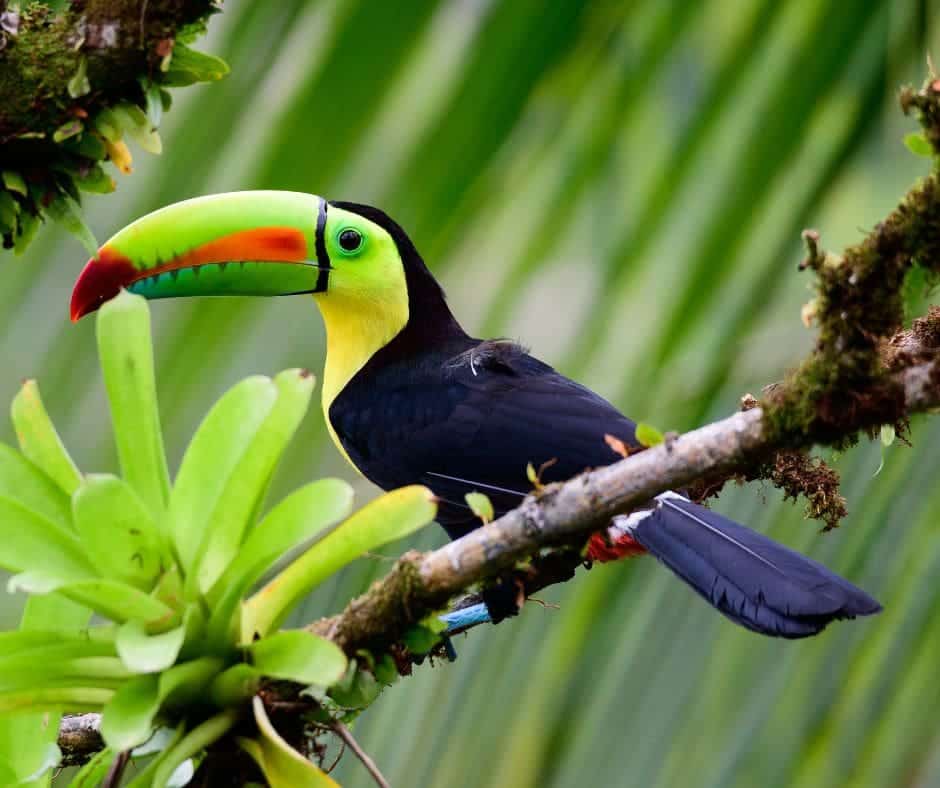Discover the Keel-Billed Toucan: Costa Rica’s Rainbow-Beaked Wonder
With a beak as colorful as a tropical fruit salad, the keel-billed toucan is a true icon of Costa Rica’s jungles. This playful bird, often seen hopping from branch to branch, boasts a beak that’s not just for show—it’s a versatile tool for foraging and playing. Explore the quirky habits and fascinating life of the toucan, from their comical calls to their unique nesting rituals. Find out where to spot these lively birds and why their presence is a testament to the rich biodiversity of Costa Rica.
A Flash of Color in the Canopy
Imagine wandering through the lush rainforests of Costa Rica, your eyes scanning the dense foliage for a glimpse of something extraordinary. Suddenly, a flash of bright color catches your attention—a brilliant blend of green, red, yellow, and blue. It’s the keel-billed toucan, also known as the “rainbow-billed toucan” for its spectacularly vibrant beak. This bird’s bill is a marvel of nature, not just for its striking colors but for its lightweight yet strong structure, perfect for the acrobatic lifestyle of this charismatic bird.
Quirky Habits and Playful Nature
Keel-billed toucans are social birds, often seen in small flocks, hopping from tree to tree in a playful manner. Their calls are a mix of croaks and squeals, almost as if they are having a lively conversation in their avian language. These birds are not shy when it comes to showing off their balancing skills, using their long bills to reach fruits that are otherwise hard to get. Their diet mainly consists of fruits, but they also snack on insects, eggs, and small reptiles, showcasing their adaptability.
One of the most amusing behaviors of the keel-billed toucan is its courtship ritual. The male toucan engages in a game of catch with the female, tossing fruit pieces back and forth with their beaks. This playful interaction strengthens their bond and eventually leads to nesting.
Nesting and Family Life
When it comes to raising a family, keel-billed toucans are quite resourceful. They nest in the cavities of trees, often using holes abandoned by woodpeckers. Despite their large bills, these birds manage to squeeze into surprisingly small spaces. Both parents take turns incubating the eggs and feeding the chicks, displaying a remarkable level of cooperation and care.
Where to Spot the Keel-Billed Toucan
For those eager to catch a glimpse of this avian wonder, Costa Rica offers several prime locations. The best places to see keel-billed toucans include:
- Tortuguero National Park: This park is a paradise for bird watchers, offering a chance to see toucans alongside other exotic wildlife.
- Monteverde Cloud Forest Reserve: Known for its misty, magical atmosphere, Monteverde is a hotspot for toucan sightings.
- Osa Peninsula: A biodiverse gem, the Osa Peninsula provides ample opportunities to observe toucans in their natural habitat.
- Arenal Volcano National Park: The lush forests surrounding the iconic volcano are home to many keel-billed toucans.
Environmental Contributions
The keel-billed toucan plays a vital role in maintaining the health of Costa Rica’s ecosystems. As frugivores, they are essential for seed dispersal. By consuming fruits and excreting the seeds, they help propagate a variety of plant species, contributing to forest regeneration and biodiversity.
Additionally, their predation on insects and small reptiles helps control these populations, maintaining a balanced ecosystem. Their presence also attracts eco-tourists, driving conservation efforts and supporting local economies.
A Symbol of Biodiversity
The keel-billed toucan is more than just a colorful bird; it is a symbol of the rich biodiversity found in Costa Rica. Its playful nature, striking appearance, and ecological importance make it a cherished resident of the country’s rainforests. By protecting the habitats of these magnificent birds, we ensure the preservation of one of nature’s most delightful spectacles.






